Review: The Tipping Point by Malcolm Gladwell.
In this book review the theory and ideas that come forward in the book The Tipping Point by Malcolm Gladwell, will be discussed.
Tipping point: one dramatic moment in an epidemic when everything can change all at once. The Tipping point is a thoroughly worked out book about the factors that play an essential role in the emergence of so called ‘social epidemics’. The book is fun and easy to read since it is packed with interesting ‘Davinci–code-like’ facts and examples of past social epidemics such as the sudden emergence of HIV in the 80-ies, emergences of fashion trends and more. According to Gladdwell the best way to understand sudden emergences is to think of it as if it were epidemics. Why do some ideas and behaviours or products spread like virusses and others don’t?
Social epidemics have three characteristics:
1. They are highly contagious
2. Little causes can have big effects
3. Change happens not gradually but at one dramatic moment
The author states three agents of this kind of change: the Law of the few, The Stickiness Factor and the Power of Context.
The Law of the Few
Epidemics tip because of the extraordinary efforts of a few select carriers; they depend on the involvement of some exceptional people who found out about a trend. These exceptional people can be divided in three types: connectors, mavens and salesmen.
Connectors
Connectors are people who link us up with the world, who know lots of people, these people are people on whom we rely more heavily than we realize. They are people with a special gift for bringing the world together. Connectors are influential as we rely on them to give us access to opportunities; jobs, fashion, movies, or anything else that moves by word-of-mouth.
Mavens
Mavens are information specialists. A maven is a person who has information on a lot of different products or prices or places. Mavens will help others by providing information based on their needs. Mavens have the knowledge and social skills to fire up word-of-mouth epidemics.
Salesmen
In social epidemics mavens supply the message and connectors spread it. Salesmen have the skills to persuade us when we are unsure about the things we hear. Research has proven that physical movements and observations can have a profound effect on how we feel and think and salesmen are extremely good in making use of these subtle physichal movements for persuasion practises.
The Stickiness Factor
Stickiness means that a message makes impact and sticks in your memory. Nowadays a consumer is exposed to hundreds of commercial messages a day, this overdose of information is called ‘clutter’. Clutter makes it harder and harder for companies to make their messages stick to consumers. Research suggests that there are simple ways for enhancing stickiness. By analysing the success of Sesame Street, Gladwell shows that people with a message can make use of several methods and instruments in able to enhance the stickiness of the message.
The Power of Context
Getting people to change their behaviour could be caused by the smallest details of their immediate enverinment. The power of context is best explained by the theory of broken windows. This theory explains how a house with broken windows influences behaviour on the street. The broken windows give an indication to people that nobody cares about the house, and this lack of concern is contagious, it spreads throughout the neighbourhood. According to Gladwell behaviour is a function of social context.
When we want to cause an epidemic and change the ideas or attitudes of our audience in a sudden en masse way this can be done through the influence of several factors. First of all we should use people of extraordinary personal connection: the Law of the Few. Secondly this can be caused by changing the content of communication and make it stick: the Stickiness Factor. The third law has to do with small changes in context that prove to be essential in tipping epidemics: the power of context.
Appealing examples and creative past research result in an overall pleasant read of The Tipping Point. Also the history and reasons for succes or failure of brand names such as Airwalk, Sesame Street and many others make this book very interesting. After having read this book I am wondering wether it is possible to completely predict, prevent or describe social epidemics. This book is a good incentive for aspects to focus on but I think a great deal of luck and random undefinable factors are also playing a major role in the event of a tipping point.
It would be interesting to do research based on Gladwells ideas on social networking sites or other potential internet epidemics. I think research related to tipping points is very usefull for investors and venture capitalists. It’s a shame that Gladwell his blog has not been updated with related theory since Januari.
A post I wrote a few weeks ago on the Dutch blog of the company I work for is closely related to The Tipping Point. It is about Yahoo and its efforts to get busy with social networks. After Yahoo had failed to take over Facebook for 1 billion dollar almost a year ago Yahoo seems to have become a little desperate.
I think Yahoo is very busy doing research on social networks and the essential elements that are described in The Tipping Point for a succesfull epidemic/social network are very important in this case. Therefore I recommend all Yahoo employees related to this social network delay/failure (who naturally are hardcore readers of the Matersofmedia weblog) to get a copy of this book and start doing their homework!
Cross-posted at Politics of Many Minds

From the perspective of Politics of Many Minds, and doing research into the ‘natively digital’ more general, the book Uses of Blogs provided me some interesting thoughts on investigating blogging and the blogosphere. This post is therefore not so much a review, but more a personal research reflection on Uses of Blogs.
It is noteworthy that most definitions of blogs focus in a good part on technological features of blogs and constrains imposed by these features. This may be the last available option if a generic description of blogs is required, without falling into poorly defined listings of possible uses of blogs. The wikipedia definition of blogs is a good example:
A blog (a portmanteau of web log) is a website where entries are written in chronological order and commonly displayed in reverse chronological order. ‘Blog’ can also be used as a verb, meaning to maintain or add content to a blog.
Many blogs provide commentary or news on a particular subject such as food, politics, or local news; others function as more personal online diaries. A typical blog combines text, images, and links to other blogs, web pages, and other media related to its topic. The ability for readers to leave comments in an interactive format is an important part of many blogs. Most blogs are primarily textual, although some focus on art (artlog), photographs (photoblog), sketchblog, videos (vlog), music (MP3 blog), audio (podcasting) or sexual topics (Adult blog), and are part of a wider network of social media.
Digital research methods rely on technological features, or ‘natively digital’ objects such as the link, the comment, and the tag. However, it is not a techno-deterministic view on the web, rather by collecting and analyzing these objects the purpose is to distill social and cultural trends from the natively digital. For my research project more specific, I want to know how politics of many minds can be distilled from investigating the natively digital.
 This review of Jean-Noël Jeanneney’s Google and the Myth of Universal Knowledge will provide the reader with an overview of the questions raised regarding the online publishing of books.
This review of Jean-Noël Jeanneney’s Google and the Myth of Universal Knowledge will provide the reader with an overview of the questions raised regarding the online publishing of books.
A View from
Branded with the tagline a View from
The argument outlined by Jeanneney finds its source in the 2004 announcement of Google to venture into the realm of digitized literary content. The Google Book Search project, as it is now called, strives toward an ambitious goal. Digitizing millions of books in a matter of years and making them freely available to the public through the well known Google search engine. With powerful institutions on their side as the Harvard and

In this review, Howard Rheingold’s vision on the future of communication and interaction is explained, as layed out in his book ‘Smart Mobs: The Next Social Revolution’, 2002.
Rheingold noted that SMS has been used for dating in teenage culture but also for the mobilization of big groups; for example in the overthrowing of the Filipinian government in 2001 or the goal orientedness of the protests in Seattle. Instead of just seeing SMS as a technology in his book, Rheingold takes you on a journey to discover the broader system that enables such a seemingly simple medium to have such a profound impact on society.
Three observations are at the basis of Rheingold’s book:
- There are ever smaller, more powerful, and cheaper computational devices,
- There is more and more ‘always on’ wireless communication to, and connectivity between, these devices,
- The people using them constitute and live in social networks which can be easily accessed anytime at any place, through these devices.
Rheingold’s central thesis is that the combination of these three offers people a new way to combine their knowledge and energy. This then gives rise to Smart Mobs: ad-hoc self organizing networks of people in the technosphere, capable of collective action. In his book he looks at how people interact with, and through, close-by and invisible ubiquitous technologies like the Internet, mobile phones, wireless and the web. He extrapolates from his observations and goes on a quest to get wiser. He foresees that the possibility to add wireless communication in every device will be another shift in the way people will interact with each other.
(more…)

Politics is always changing as society incorporates new technology for disseminating information and connecting people’ (6)
Extreme democracy is a political philosophy of the information era that puts people in charge of the entire political process. It suggests a deliberative process that places total confidence in the people, opening the policy-making to many centres of power through deeply networked coalitions that can be organized around local, national and international issues. (58 – 59). It’s clearly that the authors recognised a change in politics. Not only in the way people express their minds about certain issues but also in the way that political campaigning has changed over the past few years. According to Jon Lebkowsky and Mitch Ratcliffe blogging has become a popular form of online discourse because of its ability to contribute to the discussion of issues in the public sphere throughout the world. They provide a new approach to democratic expression uncontrollable by local authorities. (more…)
In ‘organized networks”, Australian media theorist Ned Rossiter states the urgency for new institutional forms, while ‘the uncertainties of labour and life within network societies and informational economies have all too clearly exposed the limits of prevailing institutional systems and structures’ [Rossiter].
During the past 15-20 years, (western) institutions have experienced profound difficulties in adapting to a non-representational democracy. The translation of institutional democracy into a social-technical form of the Internet has proven to constitute a large amount of problems.
Not stating that the Net is democratic by nature, there is a ‘non-state public sphere’, where ‘ cooperation, sharing, common resources, knowledge, customs, experiences and habits make possible a non-representative democracy that no longer submits to the myths and rituals of sovereignty’ [Virno].
In this non-state public sphere, immaterial labour and moreover, disorganized labour has emerged. Unlike the statement of Hardt and Negri, that due to this ‘transnational’ sphere the influence of the nation-state is diminishing, Rossiter states that national institutions (the state) still has an ‘enormous influence on regulating the movement of people and things’ [rossiter]. The problem is that ‘the state’ is doing this via the old, institutional ways, failing to adept adequately to the new ‘grammar’ of labour and capitol; that of the informational networked age.
(more…)
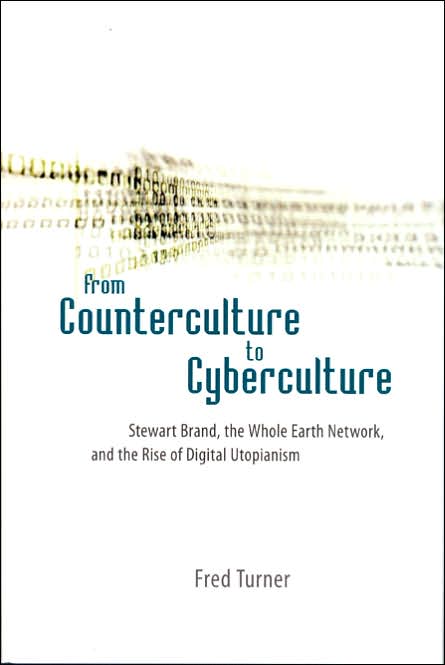
[cross-posted at default settings]
What follows is a summary and review of Fred Turner’s book, From Counterculture to Cyberculture: Stewart Brand, the Whole Earth Network and the Rise of Digital Utopianism.
Nerd Politics?
A recent Ask Slashdot piece appeared with the headline, “Why are so many nerds libertarians?” The interrogator suggests this is linked to the incompatiblity of Leftist ideals and high incomes, but a more likely answer can be sensed further down the thread (far below the funny let’s-mock-Ayn-Rand’s-stilted-prose detour):
“[T]his is the core of libertarian thought: if I’m not hurting you, leave me the hell alone. Don’t tell me what to do. Don’t order me to attend your schools. Don’t take my money for your causes. Let me trade freely (for example, let me buy sugar from Cuba). Let me read, or view, or say, what I want. I don’t need you to tell me what to do; I’m quite capable of figuring it out for myself. Let me have sex with any adult I want, male or female (n.b. I’m quite straight, but I see no reason to surpress other adults’ desires; I’m still protective of minors). Let me put into my body what I choose to put in it.
[…]
Why are so many nerds libertarian? Because you can’t code by rote. You can’t create or develop a new application following someone else’s rules. It requires individual thought, individual judgement, and individual spirit – exactly the same qualities that caused you to be either bored to tears, or jeered at, or socially ostracized at school. So when you finally come to political awareness, and realize that the GOP and the Dems are two sides of the same coin – both of them take your money, lie to you, and shove crap down your throat, while they live high on the hog on your dime (I’m not going to say which side is worse; to me, they’re both squalid), you’re eager to find a personal philosophy that avoids their traps. Libertarians are basically socially progressive and financially conservative. It seems like a logical philosophy, and we’re basically logical people.”
The author of this comment, Brickwall, suggests the trend is linked to a deep-rooted sense of individualism – thought, judgement and spirit, he says. But where he argues that this mix of ‘socially progressive and financially conservative’ politics is simply ‘logical’, one could take a different route, tracing the history of ‘nerd-politics’ to the odd marriage of Newt Gengrich’s Neo-Conservativism with the pages of Wired circa 1996, and then even further back. In From Counterculture to Cyberculture, Fred Turner does exactly this, arguing convincingly that the libertarian world-view so strongly associated with the Web, as well as the corresponding emphasis on de-regulation and on individual responsibility, is intricately tied to the project begun by a distinctive faction of 1960s counterculture, the group he terms the New Communalists.
Andrew Keen wrote the in 2007 published book ‘The cult of the Amateur’. Keen, who founded audiocafe.com a rough ten years ago, went from digital pioneer to digital skeptic. Living in Silicon Valley during the dot-com bubble and being a ‘Friend of O’Reilly’ [Foo for intimae] brought him back into the real world. In the first chapter of his book he writes about being at a camp side with a couple of hundred Silicon Valley utopians. Most of these people were very hostile towards traditional media and entertainment. Everything should be democratized, THE word of the new web. But according to Keen ‘democratization is undermining truth, souring civic discourse and belittling expertise, experience and talent’. This is the starting point for a book about the dark side of the web 2.0. Seen from different kinds of media like books, music and movies, Keen looks at all the implications that the new revolution brought with it. He definitely wrote this book with an eye on the big masses. It’s easy to read and at some points hard to stop reading.
According to all the comparisons that have been made about the users of web 2.0, Keen’s reference to the ‘ancient’ infinite monkey theory from T.H Huxley is so far the best. Imagine all the monkeys in the world having typewriters. Huxley’s theory is that one of those monkeys is going to write a masterpiece, in what form whatsoever. Now the link to web 2.0 is not easy to miss. Can all the bloggers these days be compared with Huxley’s monkeys? Keen isn’t very keen about the whole revolution that is taking place. What happens if the monkeys take over?
The first question we should ask ourselves is if the ‘monkeys’ are really just amateurs posting things on the web. In some cases big companies are behind films on Youtube or entries on Wikipedia. Is the web becoming a place where advertising isn’t even noticed anymore? An example of this is a movie that was posted online a couple of years ago by Marc Ecko. In the movie the Airforce One is tagged. The movie became really popular, only to find out after a few weeks that it was all fake and a commercial for Ecko’s clothing company. But not only companies take advantage of the new medium. Also public persons use the web to become better of it. Dutch royalties Friso and Mabel, who changed the information on the Wikipedia entry written about them their selves, to make it less critical.
But according to this, the meaning of authorship is changing too. Who owns the video’s that are on Youtube? And if someone mixes two works of a professional, can he call it his own? Or worse, can a company like Google legally use the data on our surf-behavior to make money out of it? Keen poses these questions and many more and answers them from a viewpoint that isn’t easy on the innovations side.
On September the 28th and 29th Amsterdam will be transformed into a huge playground.
A wide variety of big urban games will take place in the city……You may choose to take virtual penalties with your cell phone, play Snake live in the Westerpark or guard a VIP against snipers using a water pistol….
FOR FREE!!!
 In response to last weeks admittance of their work “44422435 to nowhere” to the Rhizome ArtBase, Entter told me that finally it seems “we are artists and not fucking nerd losers”.
In response to last weeks admittance of their work “44422435 to nowhere” to the Rhizome ArtBase, Entter told me that finally it seems “we are artists and not fucking nerd losers”.
Since 2002, Entter’s fields of research and development include, amongst many other subjects, vjing, for which they basically only use ROMS of old videogames and pixel art. This is deliberately done to explore the intrinsic visual language of videogames; a cryptic and primitive style that comes from the machines own DNA.
“44422435 to nowhere” is an experimental electronic artwork made in collaboration with Swedish 8bit musician Goto80 and his much abused instrument, the Commodore 64. The session took 3 hours but is condensed into only a few minutes. With the ‘Retro Replay’ cartridge for C64 they gained full access to the RAM, to manipulate graphics and functionality. The blue screen that appears at some points is the interface of the cartridge and the lists of letters and numbers is the data in the RAM. All manipulations were made by putting random symbols into the memory or by altering the screen graphically with PETSCII (an alternative for ASCII).
On September 23th, Entter and Goto80 will perform live in the CODA museum in Apeldoorn (NL), for the opening of a wallpaper exhibition ‘Behang, van plint tot plafond’, which will be an interesting break from their ‘normal’ setting.
“44422435 to nowhere”, (Entter and Goto80, 20 July, 2007).
(cross posted on whateverbutton.com/blog)
Over the summer I wrote an essay called ‘Interactivity is Affectivity’ for the tutorial ‘Current themes in new media’. You may like to read the following teaser, or even click pdf for the pdf.
The first thing that gets your attention on eboman.info is the list of well known web 2.0 logos. Next to it, Eboman coupled the logos to his own interpretation of what the service is about. YouTube for example lists his low-res videos, Wikipedia contains his history (actually his story, but I’ll come back to that later), Kiko holds his performance agenda, etcetera. At the top left of his site there is a call for participation: “Upload your videos to YouTube and JumpCut and make audiovisual sampletracks with Eboman”.
It looks as if the guy understands what web 2.0 is all about. There are a million definitions of web 2.0, but some of the characteristics seem to be: the Network as a (service-) platform, user -generated and -distributed content, and network effects created by an architecture of participation (deep linking). Eboman clearly calls for participation, uses different web services for various content generated by him, and uses this domain as a starting point to them.
(more…)
Olia Lialina has put her new network theory talk online. Her research catalogs ‘vintage’ Web aesthetics (including, ahem, the glitter folder). Here’s Cory Doctorow on her work:
Olia Lialina’s illustrated essay “Vernacular Web 2” builds on her earlier work, which is to “collect, classify and describe the most important elements of the early Web – visual as well as acoustic – and the habits of first Web users, their ideas of harmony and order.” The earliest days of the web were unkind to traditional designers, many of whom took some time to come to grips with floating window sizes, user-selectable fonts, and the limited palette of design elements in early HTML. The result was a folk-aesthetic, where untrained eyes and sensibilities dominated the look of the net. Much of that original look is gone now, but Lialina’s work brings it back and starts to delve into what it all means — and how its progeny still can be found online today.
Sometimes, one needs to let the youtube do the talking. Suffice to say, we’re in the thick of it.
Through Chris Perkins’ blog I found these great videos of Chomsky and Foucault. Recorded for Dutch television in 1971, it shows the two discussing their theories, being mainly the concepts of justice and power in these fragments.
Translation of ‘Mens en Computer’ (1979 – Beeld en Geluid Hilversum) item
The development from tangram to ruler to calculator all the way to the computer can be seen at the exhibition ‘Man and Computer’ in the Museum for Education in The Hague. Students of schools are familiarized with the workings of the electronic machinery which has become an essential part of modern life. The ‘chip’, an object that is getting a lot of attention lately, is also on display. The microcomputer can be built in a variety of machines and is able to significantly increase the the automatization of the industry. It is said that the chip will drastically change our lives and will cause unemployment to rise. In spite of this, the little device has as much possibilities as a room full of machinery.
At the exhibition children, aided by a large console, learn how the computer processes a program. On a small computer a spellchecker is demonstrated. The computer recalls every entered letter and lets the user know if the word has been spelled correctly. The young visitors can also practice with real computers. This way they learn the significance of input, processing and output of data. The output is often done with the use of a ‘regeldrukker’ (i.e. a printer, ed.). In a playful manner the use of computer in aeronautics is made clear. The children can reenact their own lunar landing. An erronous landing is noticed directly on the screen. The composite parts of a computer are shown systematically and the children are anxious to see the magnetic memory. Of course so-called printed circuit boards, on which the various computer components are put, are also on exhibition. And it is such a printed circuit board that can be seen in the classroom of this interesting ‘Man and Computer’ exhibition.
For three executive sunny days last week, the humanity studies faculty of the University of Amsterdam hosted the New Network Theory conference. This four party collaborative initiative – consisting of Amsterdam School of Cultural Analysis, Institute of Network cultures, University of Amsterdam, and the Hogeschool van Amsterdam – was to exploit the potential of formulating a post-Castellsian network theory which “takes technical media seriously”. Social Software and developments in technical media have influenced the Web, now is the time to document what exactly changed and formulate an up-to-date paradigm.
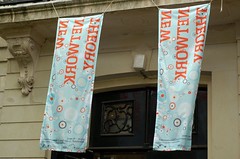 As I entered UVA grounds my eyes fell upon the two polyester banners waving above the entrance. Besides the name of the conference the banner contained a well designed background which seemed to resemble a gearing mechanism. In Dutch the word ‘raderwerk’ could describe the red, black and green mechanical wheels. ‘Raderwerk’ can be interpreted as “samengesteld geheel van menselijke organisatie” which in English translates into “compiled sum total of human organization”.
As I entered UVA grounds my eyes fell upon the two polyester banners waving above the entrance. Besides the name of the conference the banner contained a well designed background which seemed to resemble a gearing mechanism. In Dutch the word ‘raderwerk’ could describe the red, black and green mechanical wheels. ‘Raderwerk’ can be interpreted as “samengesteld geheel van menselijke organisatie” which in English translates into “compiled sum total of human organization”.
More artwork – a selection from the Places & Spaces: mapping science exhibition – decorated the conference hall.
After the essential coffee in the lobby Geert Lovink, Richard Rogers and Jan Simons officially opened a discussion that would take three days and two dinners. After some formalities Jan 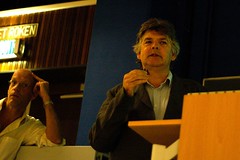 told an amusing, yet serious, anecdote of how a mere one and a half decade ago the University was linked to the outside world using one computer and a dial-up modem. The connected computer – set up by a former student – was the only place where teachers and staff members could email and browse the web, its location consequently developed into a sort of social gathering spot and perhaps in a sense a physical network surrounded this virtual interest. Thomas Elseasner spiced up the faculty with laser discs and multi media technologies; a department was born. After several name changes, nowadays Media Studies forms the largest part of the faculty of Humanities, and New Media – next to Journalism, Television Studies and Film Studies – is an independent research area.
told an amusing, yet serious, anecdote of how a mere one and a half decade ago the University was linked to the outside world using one computer and a dial-up modem. The connected computer – set up by a former student – was the only place where teachers and staff members could email and browse the web, its location consequently developed into a sort of social gathering spot and perhaps in a sense a physical network surrounded this virtual interest. Thomas Elseasner spiced up the faculty with laser discs and multi media technologies; a department was born. After several name changes, nowadays Media Studies forms the largest part of the faculty of Humanities, and New Media – next to Journalism, Television Studies and Film Studies – is an independent research area.
(more…)
A new batch of Piet Zwart master students was released into the wild yesterday. Worm(Rotterdam) hosted the temporary “invasion”, as course director Florian Cramer jokingly refered to it. The work of about 9 students, I neglected to count them precisely, was exhibited throughout the building, including the Worm office space.
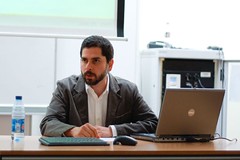 Ulises A. Mejias offers us a network critique in the final talk of the parallel session ‘Network and Subjectivities.’ In his talk about ‘Hyperlocality and the tyranny of nodes’ he argues that we can see a shift in the way we see networks. First networks were used as metaphors but now networks are used as models to organize sociality.
Ulises A. Mejias offers us a network critique in the final talk of the parallel session ‘Network and Subjectivities.’ In his talk about ‘Hyperlocality and the tyranny of nodes’ he argues that we can see a shift in the way we see networks. First networks were used as metaphors but now networks are used as models to organize sociality.
Mejias addresses four questions in his talk:
- What does nearness feel like when mediated by the network?
- How is subjectivity shaped by the network?
- To what extent are we able to influence the architectures of social participation of the network?
- What are the blind spots in the network and what do these blind spots signify? (more…)
The trouble with science is that it wants to find the truth that is valid in all cases. These speakers, it can be argued, believe that idea is not only useless, but damaging. Context is king: every culture has it’s own interpretative framework, it’s own focus points. These should be respected. In short: it’s the “culture variable” that is missing from current network theory. With video
We heard the rumor that some speakers and/or visitors would like to share their pictures with us. That would be absolutely great. So, if you have any photos you would like to share with us, please e-mail us at mastersofmedia [at] gmail [dot] com. We will put them online and share them with you. Thank you!
You can also create your own free Flickr account and share your photos with us in the New Network Theory Flickr group.
 Katy Börner, with her presentation Global Brain Pressures: Towards Scholarly Marketplaces, asks what the relationship is between knowledge and the individual, and knowledge and networks. Over a long enough timeline, one sees increasing specialization, and thus a changing perception of how knowledge is produced.
Katy Börner, with her presentation Global Brain Pressures: Towards Scholarly Marketplaces, asks what the relationship is between knowledge and the individual, and knowledge and networks. Over a long enough timeline, one sees increasing specialization, and thus a changing perception of how knowledge is produced.
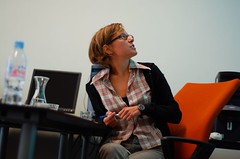 The first round of parallel sessions is underway, and a crowd has gathered in a computer lab at the Media studies department to discuss ‘the link’.. A preview comes in the form of one participant’s notes, where I spotted the question, in bold, “What about Google?!”
The first round of parallel sessions is underway, and a crowd has gathered in a computer lab at the Media studies department to discuss ‘the link’.. A preview comes in the form of one participant’s notes, where I spotted the question, in bold, “What about Google?!”
![]()
![]()
(more…)
 Noshir Contractor is the first speaker today, here to present MTML meets Web 2.0: Theorizing social processes in multidimensional networks.
Noshir Contractor is the first speaker today, here to present MTML meets Web 2.0: Theorizing social processes in multidimensional networks.
Noshir begins with a story of the social life of (technologically-enhanced) pets. Your smart-tagged dog can meet other dogs and exchange information. When your dog returns home, that information can be downloaded, you can learn about your dogs’ friends, the owners of those dogs, set up dog dates and so on. What is new today, for us even more than for pets, is the extent to which we use technology to find new social networks rather than cementing existing ones. And this creates the need for a multi-theoretical, multi-level approach to understanding social behavior.

